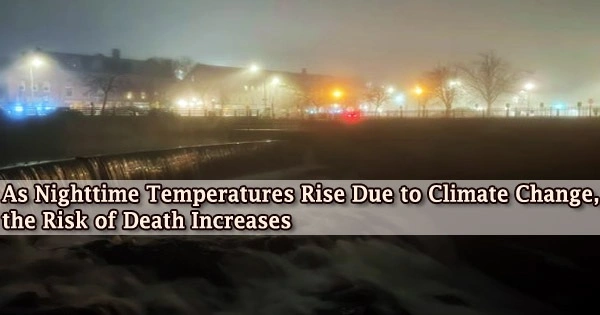A recent worldwide study that includes work from the UNC Gillings School of Global Public Health predicts that by the end of the century, mortality rates from uncomfortably hot evenings brought on by climate change will rise by up to 60% across three countries.
The typical physiology of sleep may be disrupted by ambient heat at night. A weakened immune system, increased risk of cardiovascular disease, chronic illnesses, inflammation, and mental health issues are all consequences of getting less sleep.
Results indicate that by 2090, 28 cities in east Asia will experience a nearly two-fold increase in the average hot night excess (or the excess sum of high temperatures over a particular threshold during the night), which will increase the burden of disease caused by excessive heat that disturbs regular sleeping patterns.
The effect of warmer evenings on the risk of mortality due to climate change is being estimated for the first time in this study. The results indicate that even with the Paris Climate Agreement’s limitations, the impact of heat from climate change could have a negative effect on mortality, which could be much higher than the average daily temperature increase estimates.
Climate is an area’s long-term average of weather. A change in those typical conditions is called climate change. Humans’ use of oil, gas, and coal in their homes, factories, and transportation is to blame for the rapid climate change we are currently witnessing.
These fossil fuels release greenhouse gases, primarily carbon dioxide( CO2), as they burn. The planet’s temperature increases as a result of these gases’ ability to absorb solar heat. Even more so in the short term, reducing emissions of other greenhouse gases, such as methane, can significantly slow global warming.
From our study, we highlight that, in assessing the disease burden due to non-optimum temperature, governments and local policymakers should consider the extra health impacts of the disproportional intra-day temperature variations. A more complete health risk assessment of future climate change can help policymakers for better resource allocation and priority setting.
Professor Haidong Kan
“The risks of increasing temperature at night were frequently neglected,” said study co-author Yuqiang Zhang, PhD, a climate scientist in the Department of Environmental Sciences and Engineering at the Gillings School.
“However, in our study, we found that the occurrences of hot night excess (HNE) are projected to occur more rapidly than the daily mean temperature changes. The frequency and mean intensity of hot nights would increase more than 30% and 60% by the 2100s, respectively, compared with less than 20% increase for the daily mean temperature.”
A team of researchers from China, South Korea, Japan, Germany, and the United States contributed to the study, which was published in The Lancet Planetary Health. The group calculated the excess heat-related mortality in 28 cities in China, South Korea, and Japan between 1980 and 2015 and applied it to two climate change modeling scenarios that matched the national governments’ adopted carbon-reduction forecasts.
The scientists used this model to predict that the danger of passing away from exceptionally hot nights would nearly double between 2016 and 2100. The mortality risk from daily average warming predicted by climate change models is substantially lower than this projection.
“From our study, we highlight that, in assessing the disease burden due to non-optimum temperature, governments and local policymakers should consider the extra health impacts of the disproportional intra-day temperature variations. A more complete health risk assessment of future climate change can help policymakers for better resource allocation and priority setting,” said Haidong Kan, PhD, who is a professor at Fudan University in China and the study’s corresponding author.
The authors of this study also discovered that regional variations in temperature were responsible for significant variations in nighttime temperatures, and that regions with the lowest average temperatures had the most potential for warming.
“To combat the health risk raised by the temperature increases from climate change, we should design efficient ways to help people adapt,” said Zhang.
“Locally, heat during the night should be taken into account when designing the future heatwave warning system, especially for vulnerable populations and low-income communities who may not be able to afford the additional expense of air conditioning. Also, stronger mitigation strategies, including global collaborations, should be considered to reduce future impacts of warming.”
Since the study only included 28 cities from three countries, Zhang said that “extrapolation of these results to the whole East Asia region or other regions should be cautious. Currently, based on these findings, authors are trying to extend the analysis to a global dataset. Then we could have a global picture of the deadly nighttime heat on health under climate change scenarios.”
Authors of this study include Cheng He, PhD, Yixiang Zhu, PhD, Lu Zhou, PhD, Renjie Chen, PhD, and Haidong Kan, PhD, from Fudan University in Shanghai, China; Ho Kim, PhD, from Seoul National University in Seoul, South Korea; Masahiro Hashizume, PhD, from the University of Tokyo in Tokyo, Japan; Whanhee Lee, PhD, from Ewha Women’s University, South Korea; Yasushi Honda, PhD, DrPH, from the University of Tsubuka in Tsubuka, Japan; Patrick L. Kinney, ScD, from Boston University; and Alexandra Schneider, PhD, from Heimholtz Zentrum München in Munich, Germany.
















